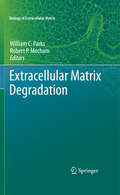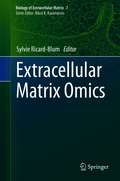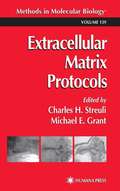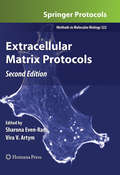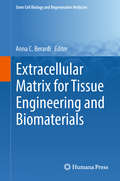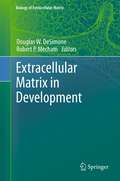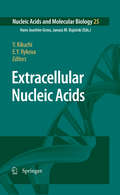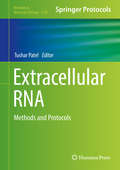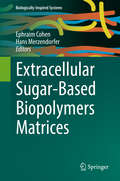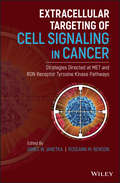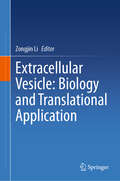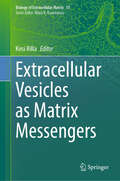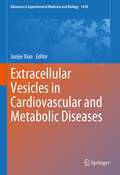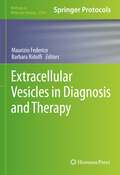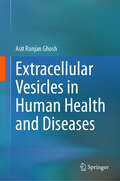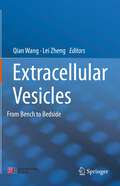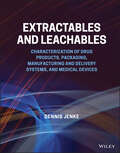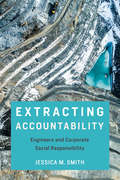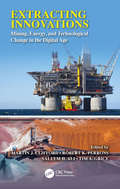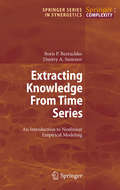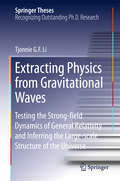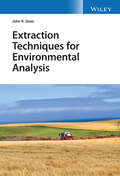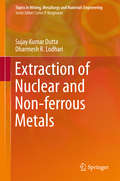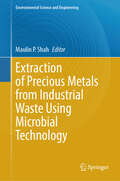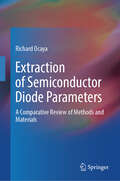- Table View
- List View
Extracellular Matrix Degradation
by Robert Mecham William C. ParksRegulated turnover of extracellular matrix (ECM) is an important component of tissue homeostasis. In recent years, the enzymes that participate in, and control ECM turnover have been the focus of research that touches on development, tissue remodeling, inflammation and disease. This volume in the Biology of Extracellular Matrix series provides a review of the known classes of proteases that degrade ECM both outside and inside the cell. The specific EMC proteases that are discussed include cathepsins, bacterial collagenases, matrix metalloproteinases, meprins, serine proteases, and elastases. The volume also discusses the domains responsible for specific biochemical characteristics of the proteases and the physical interactions that occur when the protease interacts with substrate. The topics covered in this volume provide an important context for understanding the role that matrix-degrading proteases play in normal tissue remodeling and in diseases such as cancer and lung disease.
Extracellular Matrix Omics (Biology of Extracellular Matrix #7)
by Sylvie Ricard-BlumThis book covers different omics aspects related to the extracellular matrix (ECM), namely specific omics resources focused on the extracellular matrix (e.g., databases, repositories and atlases), quantitative proteomics applied to specific extracellular matrices (e.g. basement membranes), biological processes such as ECM degradation (degradomics), cell-matrix interactions (adhesomes), signaling pathways, biomarker discovery and diseases, and interactomics (extracellular matrix interaction networks including not only protein-protein but also protein-glycosaminoglycan interactions). The volume also includes recent advances in glycomics and glycobioinformatics applied to proteoglycans and glycosaminoglycans, which are key biological players. The use of omics data to build dynamic models of ECM-regulated biological pathways is addressed, together with the requirement to standardize omic data, which is a prerequisite for the FAIR (Findability, Accessibility, Interoperability, and Reusability) guiding principles for scientific data management.This book will be of great interest to a broad readership from beginners to advanced researchers, who are interested in extracellular matrix omics and will inspire future research topics.
Extracellular Matrix Protocols
by Michael Grant Charles StreuliLeading bench-top experimentalists from around the world present, in a proven format, their state-of-the-art methods for probing the extracellular matrix (ECM), its mechanisms of assembly and how it influences cell behavior. These carefully detailed biochemical, biophysical, genetic, molecular biological, and cell biological techniques have been optimized for the study of ECM structure and assembly, the mechanisms of cell-ECM interactions, and the molecular genetics of ECM proteins and defects in human disease, and bring to a wider audience a range of highly sophisticated methods that have hitherto been difficult even for a few specialized laboratories. Cutting-edge and highly practical, Extracellular Matrix Protocols offers today's ECM researchers a gold-standard collection of powerful, readily reproducible methods to investigate the extracellular matrix and the altered cell-ECM interactions that play so important a role in human health and disease.
Extracellular Matrix Protocols
by Vira Artym Sharona Even-RamThe study of the extracellular matrix has significantly expanded over the past decade. Although thoroughly researched, the complexity and the dynamic nature of the matrix are still under extensive investigation, yielding a growing number of methods of analysis. In Extracellular Matrix Protocols: Second Edition, expert researchers explore this developing field and provide a number of techniques which can be reproduced in most cell biology labs. This edition contains methods that represent cutting edge unique technologies which are well worth exposure to the broad field and may encourage collaboration with expert labs. Chapters include information on molecular biology techniques to study gene expression, biophysical and biochemical methods for the analysis of structure and composition, and cell biology methods for assessment of cell behavior, matrix assembly and tissue engineering applications. Composed in the highly successful Methods in Molecular BiologyTM series format, each chapter contains a brief introduction, step-by-step methods, a list of necessary materials, and a Notes section which shares tips on troubleshooting and avoiding known pitfalls. Authoritative and cutting-edge, Extracellular Matrix Protocols: Second Edition investigates the diverse roles of the extracellular matrix, providing important tools for all researchers in the ECM community.
Extracellular Matrix for Tissue Engineering and Biomaterials (Stem Cell Biology and Regenerative Medicine)
by Anna C. BerardiThis volume provides a state-of-art-report on the new methodologies in tissue engineering and developments in the biomaterials field based on the extracellular matrix-relevant discovery. Extracellular Matrix for Tissue Engineering and Biomaterials opens with an overview of the latest extracellular matrix research and in Part I, focuses on its biology and its role on cell behavior and cell fate relevant for the design of biomimetic surfaces. Part II details issues regarding the strategies currently applied in the research of biologically inspired materials and material systems for the replacement, repair and regeneration of tissues and organs. Part III presents the latest development methods applying knowledge from biology towards nanotechnology, to promote the restoration of the functionality of a living tissue. The book ranges from fundamental biology associated with tissue regeneration for the development of biomimetic approaches to controlling tissue formation, cell function, differentiation and angiogenesis using factors involved in normal tissue development and function. With the breadth and depth of the coverage of this topic, this book will serve as a valuable reference for anyone working in tissue engineering or biomaterials – from scientists, chemists and biologists through physicists, bioengineers and clinicians.
Extracellular Matrix in Development
by Robert Mecham Douglas W. DesimoneCells in the developing embryo depend on signals from the extracellular environment to help guide their differentiation. An important mediator in this process is the extracellular matrix - secreted macromolecules that interact to form large protein networks outside the cell. During development, the extracellular matrix serves to separate adjacent cell groups, participates in establishing morphogenic gradients, and, through its ability to interact directly will cell-surface receptors, provides developmental clocks and positional information. This volume discusses how the extracellular matrix influences fundamental developmental processes and how model systems can be used to elucidate ECM function. The topics addressed range from how ECM influences early development as well as repair processes in the adult that recapitulate developmental pathways.
Extracellular Nucleic Acids
by Elena Y. Rykova Yo KikuchiExtracellular nucleic acids have recently emerged as important players in the fields of biology and the medical sciences. In the last several years, extracellular nucleic acids have been shown to be involved in not only microbial evolution as genetic elements but also to have structural roles in bacterial communities, such as biofilms. Circulating DNA and RNA have been found in human blood and expected to be useful as non-invasive markers for the diagnosis of several diseases. In addition, extracellular nucleic acids have attracted attention as active modulators of the immune system of higher organisms, including humans. This book covers nearly all of the newly developing fields related to extracellular nucleic acids, including those of basic biology, ecology and the medical sciences, and provides readers with the latest knowledge on them.
Extracellular RNA: Methods And Protocols (Methods In Molecular Biology #1740)
by Tushar PatelThis volume provides a collection of methods and protocols detailing extracellular RNA and hopes to be a useful resource for those interested in this exciting and emerging field. Chapters are divided into four sections covering an overview of the field, approaches for the isolation of exRNA, protocols for detection and quantitation of exRNA, and approaches that can be useful for studies to evaluate potential therapeutic applications. Written in the highly successful Methods in Molecular Biology series format, chapters include introductions to their respective topics, lists of the necessary materials and reagents, step-by-step, readily reproducible laboratory protocols, and tips on troubleshooting and avoiding known pitfalls. Authoritative and cutting-edge, Extracellular RNA: Methods and Protocols aims to ensure successful results in the further study of this vital field.
Extracellular Sugar-Based Biopolymers Matrices (Biologically-Inspired Systems #12)
by Ephraim Cohen Hans MerzendorferThe extracellular matrix (ECM) is an acellular three-dimensional network composed of proteins, glycoproteins, proteoglycans and exopolysaccharides. It primarily serves as a structural component in the tissues and organs of plants and animals, or forms biofilms in which bacterial cells are embedded. ECMs are highly dynamic structures that undergo continuous remodeling, and disruptions are frequently the result of pathological processes associated with severe diseases such as arteriosclerosis, neurodegenerative illness or cancer. In turn, bacterial biofilms are a source of concern for human health, as they are associated with resistance to antibiotics. Although exopolysaccharides are crucial for ECM formation and function, they have received considerably little attention to date.The respective chapters of this book comprehensively address such issues, and provide reviews on the structural, biochemical, molecular and biophysical properties of exopolysaccharides. These components are abundantly produced by virtually all taxa including bacteria, algae, plants, fungi, invertebrates and vertebrates. They include long unbranched homopolymers (cellulose, chitin/chitosan), linear copolymers (alginate, agarose), peptoglycans such as murein, heteropolymers like a variety of glycosaminoglycans (hyaluronan, dermatan, keratin, heparin, Pel), and branched heteropolymers such as pectin and hemicellulose.A separate chapter is dedicated to modern industrial and biomedical applications of exopolysaccharides and polysaccharide-based biocomposites. Their unique chemical, physical and mechanical properties have attracted considerable interest, inspired basic and applied research, and have already been harnessed to form structural biocomposite hybrids for tailor-made applications in regenerative medicine, bioengineering and biosensor design. Given its scope, this book provides a substantial source of basic and applied information for a wide range of scientists, as well as valuable textbook for graduate and advanced undergraduate students.
Extracellular Targeting of Cell Signaling in Cancer: Strategies Directed at MET and RON Receptor Tyrosine Kinase Pathways
by James W. Janetka Roseann M. BensonInternational experts present innovative therapeutic strategies to treat cancer patients and prevent disease progression Extracellular Targeting of Cell Signaling in Cancer highlights innovative therapeutic strategies to treat cancer metastasis and prevent tumor progression. Currently, there are no drugs available to treat or prevent metastatic cancer other than non-selective, toxic chemotherapy. With contributions from an international panel of experts in the field, the book integrates diverse aspects of biochemistry, molecular biology, protein engineering, proteomics, cell biology, pharmacology, biophysics, structural biology, medicinal chemistry and drug development. A large class of proteins called kinases are enzymes required by cancer cells to grow, proliferate, and survive apoptosis (death) by the immune system. Two important kinases are MET and RON which are receptor tyrosine kinases (RTKs) that initiate cell signaling pathways outside the cell surface in response to extracellular ligands (growth factors.) Both kinases are oncogenes which are required by cancer cells to migrate away from the primary tumor, invade surrounding tissue and metastasize. MET and RON reside on both cancer cells and the support cells surrounding the tumor, called the microenvironment. MET and RON are activated by their particular ligands, the growth factors HGF and MSP, respectively. Blocking MET and RON kinase activation and downstream signaling is a promising therapeutic strategy for preventing tumor progression and metastasis. Written for cancer physicians and biologists as well as drug discovery and development teams in both industry and academia, this is the first book of its kind which explores novel approaches to inhibit MET and RON kinases other than traditional small molecule kinase inhibitors. These new strategies target key tumorigenic processes on the outside of the cell, such as growth factor activation by proteases. These unique strategies have promising potential as an improved alternative to kinase inhibitors, chemotherapy, or radiation treatment.
Extracellular Vesicle: Biology and Translational Application
by Zongjin LiThis book focuses on the applications of extracellular vesicles (EVs) for regenerative medicine. EVs are small, lipid-bound vesicles carrying cargo that can be released by virtually all cell types. Over the past decades, the field of EV research has experienced exponential growth. Once dismissed as mere cellular debris, EVs are now recognized as sophisticated messengers, facilitating the transmission of crucial information between cells and orchestrating a myriad of biological processes. Notably, stem cell-derived EVs hold particular promise in regenerative therapeutic applications. Rich in the functional components of stem cells, these EVs offer an alternative approach to cell therapy for tissue repair and regeneration. The purpose of this book is to provide an overview of EVs on their biology, function, and potential applications. The book starts with exploring the intricate biology of EVs, their cargo, and their unique ability to modulate cellular processes. It discusses the therapeutic potential of EVs in various diseases, as well as the approaches for the bionanotechnological development of artificial EVs for theranostics. Large-scale EV isolation methods and their preclinical applications are also addressed. It will be useful for undergraduate and graduate students in medicine and cell biology, biologist, and others who are interested in such topic.
Extracellular Vesicles as Matrix Messengers (Biology of Extracellular Matrix #15)
by Kirsi RillaThe cells in our body release a wide variety of factors into the extracellular space that help to signal, regulate and build the extracellular matrix. One of the most fascinating of these factors are extracellular vesicles (EVs). These lipid membrane-covered particles have now emerged as a new powerful method of near and distant intercellular communication. EVs facilitate communication between cells and their extracellular environment, which includes solid tissues and body fluids. This volume summarizes current knowledge on EVs as integral and active components of the extracellular matrix. It covers topics such as the interplay between EVs and ECM molecules and how cancer cells modify their microenvironment by releasing EVs. Additionally, it discusses how EVs can mediate tissue repair and regeneration by modulating matrix degradation, protein cross-linking, and matrix calcification. The book explores instances where EVs play a crucial role in conditions related to matrix biology, such as cancer and arthritis, and considers their potential as therapeutic agents for these medical conditions. Both experienced researchers and clinicians, as well as PhD students who wish to study the extracellular matrix and extracellular vesicles will find this book is an excellent introduction into the field of EV biology with applications in matrix research. The series Biology of Extracellular Matrix is published in collaboration with the American Society for Matrix Biology and the International Society for Matrix Biology.
Extracellular Vesicles in Cardiovascular and Metabolic Diseases (Advances in Experimental Medicine and Biology #1418)
by Junjie XiaoThis book provides the latest research progress on Extracellular vesicles (EVs) in cardiovascular and metabolic diseases. EVs are small bilayer lipid membrane vesicles released by cells and function for intercellular communication. Increasing evidence has shown that EVs play crucial roles in cardiovascular and metabolic diseases, which seriously threaten human health worldwide. The book contains four sections: 1) Extraction Methods; 2) EVs in Cardiovascular Diseases; 3) EVs in Metabolic Diseases; and 4) Therapeutic Implications. This book is useful for biologists, cardiologists, cardiovascular surgeons, endocrinologists, internists, nurses, undergraduate and graduate students in medicine and cell biology, and others interested in cardiovascular and metabolic medicine.
Extracellular Vesicles in Diagnosis and Therapy (Methods in Molecular Biology #2504)
by Maurizio Federico Barbara RidolfiThis detailed book provides an exhaustive picture of current methods to detect, isolate, and analyze extracellular vesicles (EVs) from diverse sources, now seen as potential disease biomarkers as well as tools for the development of new therapies. Beginning with a section on detection and isolation of EVs, the volume continues with chapters covering different methods to isolate and quantify EVs from specialized tissues/organs and body fluids, methods devoted to analyzing EV components, as well as cutting-edge methods to engineer EVs. Written for the highly successful Methods in Molecular Biology series, chapters include introductions to their respective topics, lists of the necessary materials and reagents, step-by-step, readily reproducible laboratory protocols, and tips on troubleshooting and avoiding known pitfalls. Authoritative and practical, Extracellular Vesicles in Diagnosis and Therapy serves as an ideal guide for researchers seeking to learn more about the complexities of cell-to-cell communication.
Extracellular Vesicles in Human Health and Diseases
by Asit Ranjan GhoshThis book reviews the physiological and therapeutic applications of extracellular vesicles (EV) of different cell types. The initial chapter of the book focuses on their evolution, physiological functions, inter- and intra-cellular communication, and their strategic applications in defining different health disorders including aging, pathogenicity, toxicity, and drug delivery. The chapter also provides an overview of recent technologies for EV isolation, analysis, and quantification. The chapter also examines the role of EVs in viral and bacterial pathogenesis and discusses the emerging potential of EVs as diagnostic and therapeutic tools. It also discusses the emerging role of EVs including endosome-derived exosomes and fragments of the cellular plasma membrane in intercellular communication by transporting messenger RNA, microRNA (miRNA), and proteins. The book further explores the potential of membrane vesicles in the prevention, diagnosis, and treatment of inflammatory diseases,metabolic disorders, cardiovascular diseases, and neurodegenerative disorders. This book address researchers, clinicians, and doctoral and graduate students working in cellular molecular biology, cancer biology, infectious diseases, molecular medicine, biomedicine, neurobiology, microbiology, and translational medicine.
Extracellular Vesicles: From Bench to Bedside
by Qian Wang Lei ZhengThis book aims to provide a comprehensive and systematic understanding of research on extracellular vesicles (EVs). Extracellular vesicles, including exosomes and microvesicles, are nano-sized lipid bilayer encapsulated membranes carrying proteins, lipids, nucleic acids. They are shed by the majority of the cells into the extracellular milieu and present in many biological fluids (blood, urine, saliva, breast milk, cerebrospinal fluid, follicular fluid, semen, lung lavage, and tears). With numerous research publications in recent years, the study of EVs is the emerging field across plenty of disciplines. Many researches and efforts have shown their biogenesis, multiple roles in physiological and pathophysiological processes, and their potential roles as therapeutic agents. The book is organized by outstanding scientists in EV field from the Chinese Society for Extracellular Vesicle (CSEV). It covers the biological basic research of EVs, especially on technologies and methods, as well as the clinical application of EVs as biomarkers for disease diagnosis and therapy.
Extractables and Leachables: Characterization of Drug Products, Packaging, Manufacturing and Delivery Systems, and Medical Devices
by Dennis JenkeEXTRACTABLES AND LEACHABLES Learn to address the safety aspects of packaged drug products and medical devices Pharmaceutical drug products and medical devices are expected to be effective and safe to use. This includes minimizing patient, user or product exposure to impurities leached from these items when the drug product is administered or when the medical device is used. Clearly, patient or user exposure to leachables must not adversely impact their health and safety. Furthermore, these impurities must not adversely affect key quality attributes of the drug product or medical device, including its manufacturability, stability, efficacy, appearance, shelf-life and conformance to standards. Extractables and leachables are derived from the drug product’s packaging, manufacturing systems and/or delivery systems or from the medical device’s materials of construction. It is imperative to understand and quantify the release of extractables from these items, the accumulation of leachables in drug products and the release of leachables from medical devices. Once extractables and leachables have been discovered, identified and quantified, their effect on the key product or device quality attributes, including safety, must be systematically and scientifically established according to recognized, rigorous and relevant regulatory and compendial standards and industry-driven best practices. In Extractables and Leachables, the chemical compatibility (including safe use) of drugs (and their containers, delivery devices and manufacturing systems) and medical devices is examined at length, focusing particularly on how trace-level extractables and leachables affect the quality and safety of a medical product and how to assess the magnitude of the effect. This is accomplished by addressing the two critical activities required to develop, register and commercialize safe, effective and affordable clinical therapies; measuring extractables and leachables (chemical characterization) and assessing their impact (for example, toxicological safety risk assessment). Each of these activities is addressed in-depth, based on the existing and developing international regulations and guidelines, current published literature and the author’s extensive personal experience. Written by a key contributor to standards, guidelines, recommended practices and the scientific literature, the book provides “insider” insights beyond those gained by merely reading the relevant texts. Given that the rapidly evolving extractables and leachables landscape, this book provides the most current and crucial information on new and forthcoming regulations and best practices. Extractables and Leachables readers will also find: A thorough summary of regulatory and compendial guidelines and the steps required to meet them A detailed and in-depth review of essential scientific principles and recommended best practices for the design, implementation, interpretation and reporting of chemical characterization studies A practical resource for optimizing the development, registration, and commercialization of safe and effective medical products A helpful tool to maximize product development and successful regulatory outcomes Extractables and Leachables is the essential reference for pharmaceutical scientists, analytical chemists, regulatory affairs professionals, engineers, and toxicologists in areas such as product research and development, product registration and approval, regulatory affairs, analytical science, quality control, and manufacturing.
Extracting Accountability: Engineers and Corporate Social Responsibility (Engineering Studies)
by Jessica SmithHow engineers in the mining and oil and gas industries attempt to reconcile competing domains of public accountability.The growing movement toward corporate social responsibility (CSR) urges corporations to promote the well-being of people and the planet rather than the sole pursuit of profit. In Extracting Accountability, Jessica Smith investigates how the public accountability of corporations emerges from the everyday practices of the engineers who work for them. Focusing on engineers who view social responsibility as central to their profession, she finds the corporate context of their work prompts them to attempt to reconcile competing domains of accountability—to formal guidelines, standards, and policies; to professional ideals; to the public; and to themselves. Their efforts are complicated by the distributed agency they experience as corporate actors: they are not always authors of their actions and frequently act through others. Drawing on extensive interviews, archival research, and fieldwork, Smith traces the ways that engineers in the mining and oil and gas industries accounted for their actions to multiple publics—from critics of their industry to their own friends and families. She shows how the social license to operate and an underlying pragmatism lead engineers to ask how resource production can be done responsibly rather than whether it should be done at all. She analyzes the liminality of engineering consultants, who experienced greater professional autonomy but often felt hamstrung when positioned as outsiders. Finally, she explores how critical participation in engineering education can nurture new accountabilities and chart more sustainable resource futures.
Extracting Innovations: Mining, Energy, and Technological Change in the Digital Age
by Martin J. Clifford, Robert K. Perrons, Saleem H. Ali and Tim A. GriceThis book considers the most contemporary innovations propelling the extractive industries forward while also creating new environmental and social challenges. The socio-ecological fabric of innovation in the extractive industries is considered through an integrative approach that brings together engineers, natural scientists, and social scientists—academics and practitioners—giving an empirically grounded and realistic evaluation of the innovations in this sector. It synthesizes a series of questions including:
Extracting Knowledge From Time Series: An Introduction to Nonlinear Empirical Modeling
by Boris P. Bezruchko Dmitry A. SmirnovThis book addresses the fundamental question of how to construct mathematical models for the evolution of dynamical systems from experimentally-obtained time series. It places emphasis on chaotic signals and nonlinear modeling and discusses different approaches to the forecast of future system evolution. In particular, it teaches readers how to construct difference and differential model equations depending on the amount of a priori information that is available on the system in addition to the experimental data sets. This book will benefit graduate students and researchers from all natural sciences who seek a self-contained and thorough introduction to this subject.
Extracting Physics from Gravitational Waves
by Tjonnie G. F. LiTjonnie Li's thesis covers two applications of Gravitational Wave astronomy: tests of General Relativity in the strong-field regime and cosmological measurements. The first part of the thesis focuses on the so-called TIGER, i. e. Test Infrastructure for General Relativity, an innovative Bayesian framework for performing hypothesis tests of modified gravity using ground-based GW data. After developing the framework, Li simulates a variety of General Relativity deviations and demonstrates the ability of the aforementioned TIGER to measure them. The advantages of the method are nicely shown and compared to other, less generic methods. Given the extraordinary implications that would result from any measured deviation from General Relativity, it is extremely important that a rigorous statistical approach for supporting these results would be in place before the first Gravitational Wave detections begin. In developing TIGER, Tjonnie Li shows a large amount of creativity and originality, and his contribution is an important step in the direction of a possible discovery of a deviation (if any) from General Relativity. In another section, Li's thesis deals with cosmology, describing an exploratory study where the possibility of cosmological parameters measurement through gravitational wave compact binary coalescence signals associated with electromagnetic counterparts is evaluated. In particular, the study explores the capabilities of the future Einstein Telescope observatory. Although of very long term-only applicability, this is again a thorough investigation, nicely put in the context of the current and the future observational cosmology.
Extraction Techniques for Environmental Analysis
by John R. DeanExtraction Techniques for Environmental Analysis Explore the analytical approach to extraction techniques In Extraction Techniques for Environmental Analysis, accomplished environmental scientist and researcher John R. Dean delivers a comprehensive discussion of the extraction techniques used for organic compounds relevant to environmental analysis. In the book, extraction techniques for aqueous, air, and solid environmental matrices are explored and case studies that highlight those techniques are included. Readers will find in-depth treatments of specific extraction techniques suitable for adoption in their own laboratories, as well as reviews of relevant analytical techniques used for the analysis of organic compound extracts (with a focus on chromatographic separation and detection). Extraction Techniques for Environmental Analysis also includes a chapter that extensively covers the requirements for an analytical laboratory, including health and safety standards, as well as: A thorough introduction to pre-sampling, as well as the extraction of aqueous samples, including the classical approach for aqueous extraction and solid phase extraction Comprehensive explorations of the extraction of gaseous samples, including air sampling Practical discussions of the extraction of solid samples, including pressurized fluid extraction and microwave-assisted extraction In-depth examinations of post-extraction procedures, including pre-concentration using solvent evaporation Extraction Techniques for Environmental Analysis is a must-read resource for undergraduate students of applied chemistry, as well as postgraduates taking analytical chemistry courses or courses in related disciplines, like forensic or environmental science.
Extraction of Nuclear and Non-ferrous Metals
by Sujay Kumar Dutta Dharmesh R. LodhariThis book presents a comprehensive overview of non-ferrous metallurgy, especially its core principles and fundamental aspects, in a concise form. The book covers all basic concepts and definitions related to metal extraction, and provide succinct summaries of relevant metallurgical processes. It also covers the scientific and engineering aspects of nuclear processes and features special chapter on ultra-high-purity metals. The book employs a step-by-step approach, is written in an easy-to-understand style, and discusses significance of core concepts. As such, it not only offers a valuable guide for professionals and researchers working in the areas of metallurgy, mining, and chemical engineering, but can also be used as a core text in both graduate and professional coursework.
Extraction of Precious Metals from Industrial Waste Using Microbial Technology (Environmental Science and Engineering)
by Maulin P. ShahThis book discusses the methods of biorecovery of various metals and includes current challenges and prospects of biorecovery of metals. Millions of tons of electrical and electronic equipment wastes are being generated worldwide out of which a very small fraction is properly collected and recycled, while the majority ends up in landfills. Loss of critical raw materials in this represents an unnecessarily high cost to the economy and a pressing need to develop cheap and sustainable recycling process. Bacteria such as Cupriavidus sp. can tolerate high concentration of metals such as silver and extracellularly synthesize silver nanoparticles (AgNPs). Such solubilize metals owing to various metabolic products thus help in biologically recovering these resources. Biorecovery of metals is important due to the need for resource conservation. In certain electroplating industries especially involving precious metals such as silver, gold, platinum, and palladium, the wastewater contains adequate amounts of precious and valuable metals. A suitable wastewater treatment is required not only to remove the heavy metals but also to recover those precious and valuable metals for both growing economy and to reduce dependence on import and for environmental concerns.
Extraction of Semiconductor Diode Parameters: A Comparative Review of Methods and Materials
by Richard OcayaThis book presents a comprehensive treatise on the extraction of semiconductor diode parameters using various methods. Its focus is on metal-semiconductor, metal-insulator-semiconductor, and p-n junction diodes, covering a wide range of metals and semiconductors, including elemental, compound, organic, and nanostructured materials. By bringing together these methods in one place, this book provides a much-needed standardized point of reference for the field. The methods used for device characterization have spread widely but not yet critically compared and contrasted. This book aims to bridge this gap by offering a comparative review of the methods and providing the most accurate information on current developments. The result is a valuable resource for researchers and practitioners who seek to optimize their use of semiconductor diodes in their work. With its thorough coverage and critical analysis, this book fills a large void in the field of semiconductor device characterization. It is an essential reference for anyone interested in the extraction of semiconductor diode parameters using a variety of methods.
